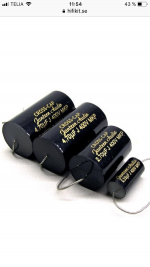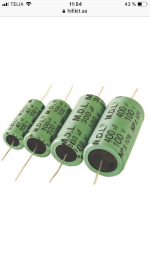Hello people!
I have a question,im am building a crossover for now,what is the big difference between a 22uf 400v capasitor and a 22uf 100v ?
I have the green elektrolyte for testing my setup,but thinking is it a big difference to change to jantzens black more expensive capasitors?
I have a question,im am building a crossover for now,what is the big difference between a 22uf 400v capasitor and a 22uf 100v ?
I have the green elektrolyte for testing my setup,but thinking is it a big difference to change to jantzens black more expensive capasitors?
Attachments
The green coloured capacitors are NP electrolytics. Perform very well in crossovers.
The black ones are Metallised Polypropylene and are also good for crossovers.
The main difference is the cost. The voltages used in crossovers rarely exceed 100volts. Any higher working voltage of capacitor is a waste of money.
The black ones are Metallised Polypropylene and are also good for crossovers.
The main difference is the cost. The voltages used in crossovers rarely exceed 100volts. Any higher working voltage of capacitor is a waste of money.
The dielectric absorption, and noise will be higher in the electrolytic parts. The esr will be much lower in the higher voltage film capacitors. Whether or not that will affect your application is not known for certain, but likely.
Should probably dig around on the multi-way forum here to get better answers soon to applications.
Should probably dig around on the multi-way forum here to get better answers soon to applications.
Electrolytics will age eventually and change value, and have measurable distortion and slacker tolerances. Polypropylene perform better, won't age, but bulkier and more expensive.
If the amp has upto +/-50V rails then 100V will be fine. 400V for the film caps is mainly because that's the rating of the film used (thinner films are presumably more tricky to handle at manufacturer without flaws).
If the amp has upto +/-50V rails then 100V will be fine. 400V for the film caps is mainly because that's the rating of the film used (thinner films are presumably more tricky to handle at manufacturer without flaws).
I wasn't be so sure about 100 V rated caps in crossover (for +-50V amplifier). There are frequency, current, etc limitattions, so we usually have to encrease rated voltage much higher than for just DC.
Agreed, it's for the full swing of the dual-rails, and some of those exceed 100V peak to peak at full power. 250V is the typical lowest recommended voltage for not exceeding the caps ratings in most SS amplifiers, however, some older SS as well as some newer class D amps have +/-110VDC rails, and being the ROT of twice the capacity would yield a VDC of just over 400 for safety margins.
For these reasons, I try to not use less than 400V caps in most situations.
Later,
Wolf
For these reasons, I try to not use less than 400V caps in most situations.
Later,
Wolf
- Status
- Not open for further replies.

